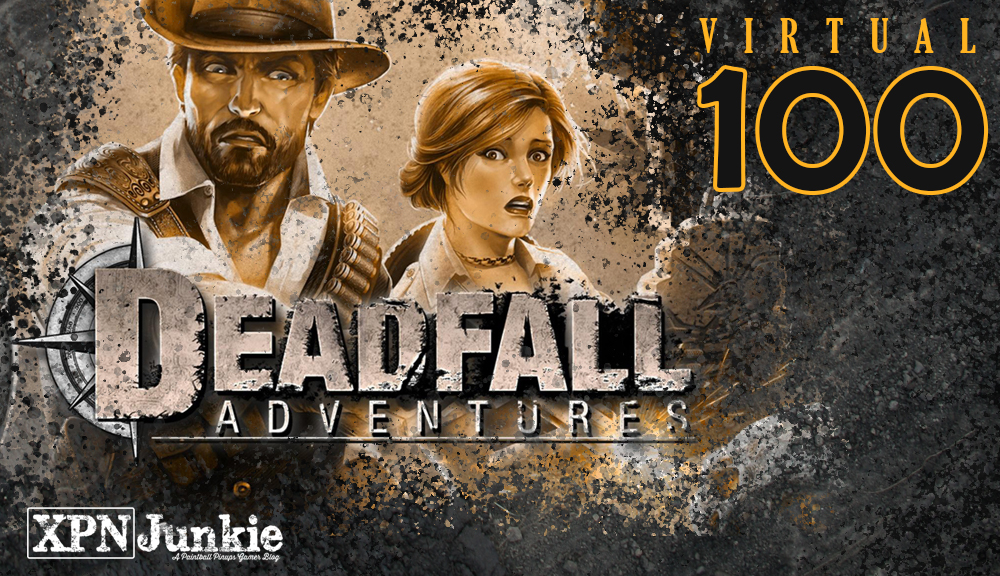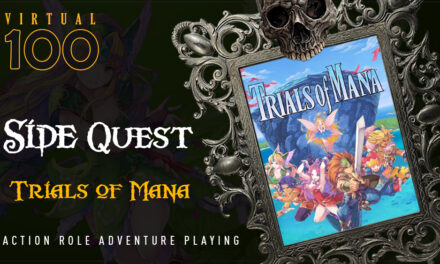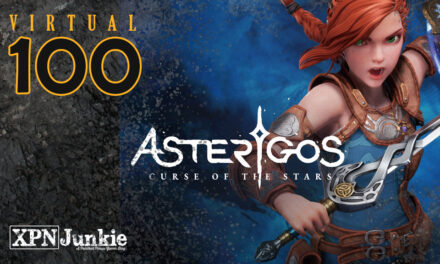Virtual 100 – Game 4
Move over, Nathan Drake! Step aside Indiana Jones! Back the **** off, Lara Croft! It’s time for Allan Quater- I mean JAMES Quatermain to have his time in the spotlight.
My earliest memories of Allan Quatermain were from being a kid in the 80’s and watching Richard Chamberlain play the role of the famous adventurer. He starred in two movies, King Solomon’s Mines and Allan Quatermain and the Lost City of Gold.
Now, these books date back to the 1800’s and were most likely the inspiration for Indiana Jones, but as a kid all I could think was, “WTF is this Indiana Jones knockoff shit?”
But enough about that, because this isn’t even about Allan Quatermain. It’s about his great-grandson James, who not only never existed in the books, but also for whatever reason, is American.
I realize that he’s a few generations removed, and could very well have been born and raised in the US, but that’s not where the story picks up, and all the other characters are English, so the fact they made a conscious decision to NOT have James be English as well is just kinda weird. They also double-down on this by having James repeatedly ask how his contractors managed to talk Uncle Sam into funding this. Or something like that.
What Uncle Sam has to do with English archaeologists doing archeology in places that aren’t the US is beyond me. Perhaps I missed something in the intro, I’m not sure.
Anyways, the game starts in Egypt, with a pair of English archaeologists approaching Jimmy Q with a proposition. James is a product of his great-grandpappy’s legacy after all, and everyone just assumes he will take on any archaeological gig that is offered to him (can’t imagine why). In any case, James reluctantly accepts, and the game begins with he and his new partner Jennifer exploring an Egyptian tomb. It’s not long before they realize they’re not the only ones looking for… the thing that they went looking for. It’s apparently an item of interest for none other than the Nazi army. Because of course.
What follows is a rather predictable story filled with action, excitement, and double-crosses, with a bit of a supernatural element thrown in for shits and giggles. In other words, it’s an Indiana Jones flick. And not a very good one at that.
While it never quite reaches Kingdom of the Crystal Skull levels of silliness, it never really gets that interesting either. Despite globe-trotting from Egyptian tombs, to Atlantean ice temples, to Mayan ruins, the action never really gets going. Every time the player starts to experience anything resembling “fun” the game is sure to throw a puzzle at them to bring everything to a screeching halt.
This game is primarily a puzzle game, and man does it screw with the pacing of the game. If I had to guess, I’d say the game has an puzzle-to-action ratio of about 80:20. Where most adventuring games use puzzles as a means to break up the action and give the player a moment to breathe, Deadfall Adventures does the opposite, presenting the player with puzzle after puzzle, with a few shootouts sprinkled here and there to keep you from falling asleep.
Fall asleep I did. A few times. Mainly because these puzzles are never really that difficult in terms of the solution, but a lot of times I ran into a mechanic… or function… that was not made apparent enough to me.
For example, any gamer that’s played anything that has environmental puzzles of even the simplest design can see the logic sign-posted in front of them. Ledges that can be climbed up usually have some kind of tell-tale markings. Whether they’re a brightly colored cloth, or scratch marks from where others have climbed, or a streak of white paint.. Whatever it may be, there’s at least some symbolism there to inform the gamer that “hey, you can climb this.”
Same goes for interactive objects that flash or sparkle. You see them and you just automatically know that you can interact with it. The problem with Deadfall Adventures is that it follows this logic, but only sometimes. A certain puzzle may have interactive elements that flash or are painted gold, but also sometimes have an additional element that must also be interacted with, that isn’t any of those thins. So the player is left fiddling with the things they know they can move or rotate, or whatever, while maybe completely overlooking another element of the puzzle that has no discernable interactivity.
The player is aided somewhat by an omnipotent notebook that James carries on him that magically has the solutions to puzzles that people supposedly haven’t seen in thousands of years. It’s a nice tool, and as the player, you will use it quite often. But even that can range anywhere from being woefully unhelpful to straight up giving you the answer. At times I wondered why the puzzle even existed. For instance, there is one puzzle late in the game where there are is a row of pedestals that the player has to touch in a specific order. Pulling up the notebook will show an illustration of these pedestals with the numbered order literally written above them. All the player has to do is just follow the picture. There’s no thought or logic involved.
Does it add some simple interactivity? Sure. Is it something I still want to be doing at the end of the game? No. No it’s not.
That’s not to say all the puzzles are bad. Most of them, and I will give them some credit, are creatively thought out, even if they aren’t necessarily tricky. You won’t find anything on the level of a Tomb Raider here. Most puzzles, once the player knows just what they’re supposed to do, can be solved in a minute or two. Rarely are they long enough or complicated enough to elicit a groan….
Oh.. No… wait hold on. There is one. One puzzle that I absolutely felt like kicking someone in the nuts for. It’s a sliding tile puzzle.
No one. Nowhere. Should EVER have to do a sliding tile puzzle. They’re not fun. They have no redeeming qualities whatsoever, and whether there is a scientific process to solve it or not, doesn’t matter. Anyone worth their salt, who values their time, will click like madness on every tile as fast as they can until they accidentally get close enough to the solution where a few conscious moves can finish it off.
I hate sliding tile puzzles. It’s a passion that goes back quite a ways, to when I was a wee lad of about 12, sitting in Business Computer Applications class in 8th grade. It was the early 90’s and those little shitty black and white MacIntosh Classics were what we had to learn computer stuff on. There was nothing on them, except for Clarisworks… and one shitty little sliding tile puzzle. You had your choice between numbers or the Apple logo. And if you were a kid in the early 90’s and the teacher is droning on and on about tabs and double-spacing, you were likely clicking away on that fucking tile puzzle. I hated it then, and I hate it now.
But that’s all beside point. I can at least verify that completing the puzzle is completely optional and yes, I did complete it, quite angrily.
Some of these puzzles wouldn’t be so bad, but instead of allowing manual saves, the game uses a checkpoint system and it is very, very stingy. Most games will automatically save after a treasure is found or a puzzle is solved, but not Deadfall Adventures. If you complete that puzzle, and then die, or lighting strikes a telephone pole outside your house and the power blinks, you get to do it all over again! Fun times.
It’s not all bad though, the game, for what it’s worth, actually looks quite good. I mean, not the character models or animation, they look like Team America World Police, but the tombs and environments are pleasing to the eye and in some places, the game actually fared better than I expected. Out of all the problems I had with the game, the graphics actually weren’t one of them. Sure, there were some quirks, but for the most part, I liked what I saw.
As far as the controls go, it’s a mixed bag. The guns feel fine and shooting them works well enough, I suppose. They’re pretty basic, especially after playing so much Call of Duty, but they do what they need to do and I don’t think I hated any one particular weapon in the game. It also helped that the enemies weren’t bullet sponges, something I greatly appreciated. A few shots from an MP40 or even your base revolvers was usually enough to take down human enemies, while the mummies and skeletons required an Alan Wake-ish blast from a flashlight in order to make them vulnerable.
The game mixes it up a little in the later stages, tossing in traps and mirrors that can be used to the player’s advantage to help take them out, but honestly, if you’re at least keeping an eye out for the hidden treasures, your upgraded flashlight will be more than capable of exposing the mummies’ weaknesses.
For the most part, the game is pretty straightforward, with few surprises to write home about. There was a pretty lengthy Temple of Doom-esque mine cart segment that went on far longer than I expected and was actually pretty elaborate and fun. It’s a shame the game didn’t have more set-pieces like that, as I think it would’ve really helped to make the game stand out at the time.
A couple of weird quirks I noticed. For whatever reason, the control settings would reset after I quit out of the game. This wouldn’t be a huge deal if I weren’t one of the heathens that prefers my Y-axis inverted. Every single time I booted up the game, I had to go into the options and invert the controls. It was… annoying.
Also, and this was a me problem, but this game had zero consideration for a dead zone in the left analog stick, and exposed a stick drift in my controller I didn’t know I had. This resulted in the controls being really floaty, and there were some times when a puzzle or platform required very careful movement, and this controller issue just exasperated the problem. More than once, James plummeted to his death after hitting a switch or turning a mirror due to him just randomly deciding to walk forward into the pool of lava when I wasn’t paying attention. Again, this was my experience with my worn out controller, but I can’t say it won’t happen to anyone else.
Aside from all that though, the game itself is… fine.
I don’t remember how I acquired this game, if it was through Xbox’s Games with Gold, or if I bought it on sale for $3 or $4, but in any case I know I didn’t pay much for it. Deadfall’s biggest problem is that it doesn’t try to do anything new or different. It’s unapologetically mediocre. And might I note that this game came out in 2013, the same year as the Tomb Raider reboot. Say what you will about that TR game, but I played the crap out of it back on 360 and have even beaten it a time or two again after it released for Xbox One. But that game was as successful as it was because it tried new things. And of course, because it was excellent.
Deadfall Adventures isn’t really a bad game. It has a lot of little nagging issues, some repetitive enemies, and an antagonist that looks like an evil mannequin, but none of them really make the game unplayable. If you really like these types of games, it might be worth a look.
But I’ll be honest, if you must check it out, try to do it on PC, as I’m sure some of the aliasing issues are probably not as prevalent, you can force a higher framerate, and it likely has manual saves. It’s sure to be a more polished experience.
That’s game number four on the grid. I feel like I’m off to a good start, but it’s a long road ahead, and early 2024 is going to test my resolve with all of its upcoming releases. Here’s to getting as many removed as possible before that happens.






